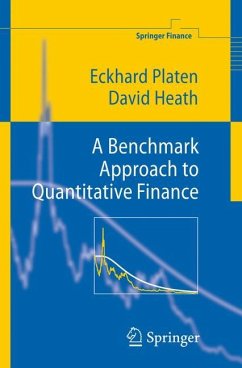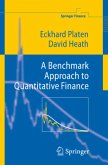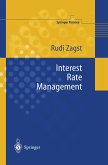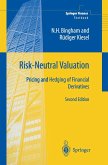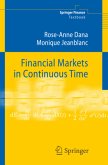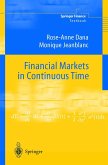The benchmark approach provides a general framework for financial market modeling, which extends beyond the standard risk-neutral pricing theory. It permits a unified treatment of portfolio optimization, derivative pricing, integrated risk management and insurance risk modeling. The existence of an equivalent risk-neutral pricing measure is not required. Instead, it leads to pricing formulae with respect to the real-world probability measure. This yields important modeling freedom which turns out to be necessary for the derivation of realistic, parsimonious market models. The first part of the book describes the necessary tools from probability theory, statistics, stochastic calculus and the theory of stochastic differential equations with jumps. The second part is devoted to financial modeling by the benchmark approach. Various quantitative methods for the real-world pricing and hedging of derivatives are explained. The general framework is used to provide an understanding of the nature of stochastic volatility. The book is intended for a wide audience that includes quantitative analysts, postgraduate students and practitioners in finance, economics and insurance. It aims to be a self-contained, accessible but mathematically rigorous introduction to quantitative finance for readers that have a reasonable mathematical or quantitative background. Finally, the book should stimulate interest in the benchmark approach by describing some of its power and wide applicability.
In recent years products based on ?nancial derivatives have become an ind- pensabletoolforriskmanagersandinvestors. Insuranceproductshavebecome part of almost every personal and business portfolio. The management of - tual and pension funds has gained in importance for most individuals. Banks, insurance companies and other corporations are increasingly using ?nancial and insurance instruments for the active management of risk. An increasing range of securities allows risks to be hedged in a way that can be closely t- lored to the speci?c needs of particular investors and companies. The ability to handle e?ciently and exploit successfully the opportunities arising from modern quantitative methods is now a key factor that di?erentiates market participants in both the ?nance and insurance ?elds. For these reasons it is important that ?nancial institutions, insurance companies and corporations develop expertise in the area of quantitative ?nance, where many of the as- ciated quantitative methods and technologies emerge. This book aims to provide an introduction to quantitative ?nance. More precisely, it presents an introduction to the mathematical framework typically usedin?nancialmodeling,derivativepricing,portfolioselectionandriskm- agement. It o?ers a uni?ed approach to risk and performance management by using the benchmark approach, which is di?erent to the prevailing paradigm and will be described in a systematic and rigorous manner. This approach uses the growth optimal portfolio as numeraire and the real world probability measure as pricing measure.
Hinweis: Dieser Artikel kann nur an eine deutsche Lieferadresse ausgeliefert werden.
In recent years products based on ?nancial derivatives have become an ind- pensabletoolforriskmanagersandinvestors. Insuranceproductshavebecome part of almost every personal and business portfolio. The management of - tual and pension funds has gained in importance for most individuals. Banks, insurance companies and other corporations are increasingly using ?nancial and insurance instruments for the active management of risk. An increasing range of securities allows risks to be hedged in a way that can be closely t- lored to the speci?c needs of particular investors and companies. The ability to handle e?ciently and exploit successfully the opportunities arising from modern quantitative methods is now a key factor that di?erentiates market participants in both the ?nance and insurance ?elds. For these reasons it is important that ?nancial institutions, insurance companies and corporations develop expertise in the area of quantitative ?nance, where many of the as- ciated quantitative methods and technologies emerge. This book aims to provide an introduction to quantitative ?nance. More precisely, it presents an introduction to the mathematical framework typically usedin?nancialmodeling,derivativepricing,portfolioselectionandriskm- agement. It o?ers a uni?ed approach to risk and performance management by using the benchmark approach, which is di?erent to the prevailing paradigm and will be described in a systematic and rigorous manner. This approach uses the growth optimal portfolio as numeraire and the real world probability measure as pricing measure.
Hinweis: Dieser Artikel kann nur an eine deutsche Lieferadresse ausgeliefert werden.
From the reviews:
"The book under review introduces quantitative finance using the benchmark approach. ... It is quite a nice blend of narrative and mathematics. There are also some bigger examples which contribute nicely to the overall presentation. ... Exercises are provided at the end of each chapter. The authors even provide solutions to exercises. ... I think it could be quite useful for students, because of the first part of the book, and to practitioners, due to the exposition in the second part of the book."
(Ita Cirovic Donev, MathDL, March, 2007)
"This book provides an introduction to quantitative finance. ... It aims to stimulate interest in the benchmark approach by describing some of its power and wide applicability. It is intended for quantitative analysts postgraduate students, practioners in finance, economics and insurance. ... It is designed for three groups of users. Firstly, it provides useful information to financial analysts and practioners. Secondly, it aims to introduce those with a reasonable basic mathematical background. Thirdly, researchers may find the later parts of the book interesting ... ."
(Klaus Ehemann, Zentralblatt MATH, Vol. 1104 (6), 2007)
"The book is a rather comprehensive treatment of quantitative finance and distinguishes itself from other analogous treatments by using a novel approach that allows one to generalize various existing results and to some extent also allows one to bridge a certain gap between current and classical approaches. ... The comprehensiveness of the book is very valuable for research ... ."
(Wolfgang J. Runggaldier, Mathematical Reviews, Issue 2008 d)
"The book under review introduces quantitative finance using the benchmark approach. ... It is quite a nice blend of narrative and mathematics. There are also some bigger examples which contribute nicely to the overall presentation. ... Exercises are provided at the end of each chapter. The authors even provide solutions to exercises. ... I think it could be quite useful for students, because of the first part of the book, and to practitioners, due to the exposition in the second part of the book."
(Ita Cirovic Donev, MathDL, March, 2007)
"This book provides an introduction to quantitative finance. ... It aims to stimulate interest in the benchmark approach by describing some of its power and wide applicability. It is intended for quantitative analysts postgraduate students, practioners in finance, economics and insurance. ... It is designed for three groups of users. Firstly, it provides useful information to financial analysts and practioners. Secondly, it aims to introduce those with a reasonable basic mathematical background. Thirdly, researchers may find the later parts of the book interesting ... ."
(Klaus Ehemann, Zentralblatt MATH, Vol. 1104 (6), 2007)
"The book is a rather comprehensive treatment of quantitative finance and distinguishes itself from other analogous treatments by using a novel approach that allows one to generalize various existing results and to some extent also allows one to bridge a certain gap between current and classical approaches. ... The comprehensiveness of the book is very valuable for research ... ."
(Wolfgang J. Runggaldier, Mathematical Reviews, Issue 2008 d)

